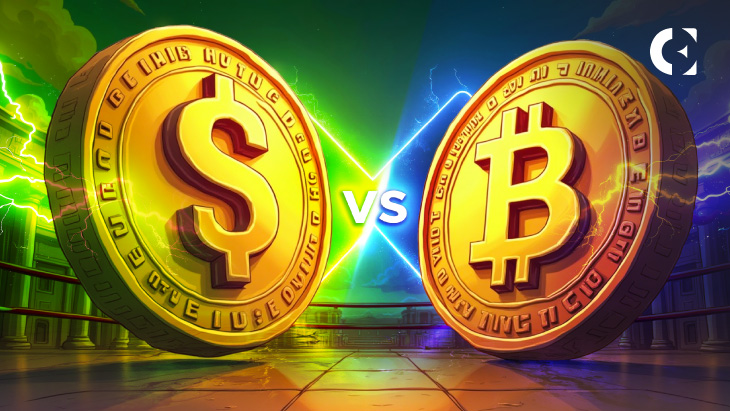Money has come a long way from shells, beads, and metal coins. For most of modern history, we’ve depended on government-issued currency, the paper bills and coins we carry in our wallets, or more recently, the digital balances in our bank accounts. But in the last decade, a new kind of money has entered the scene and captured global attention: Cryptocurrency.
Unlike the dollars, euros, or rupees we’re used to, cryptocurrencies like Bitcoin and Ethereum aren’t controlled by any government or central bank. They’re digital, decentralized, and run on cutting-edge blockchain technology. In this article, we’ll take a closer look at how cryptocurrency compares to government currency, breaking down their key differences in how they’re created, controlled, used, and valued.
Table of contents
Difference between Fiat and Crypto
Basically, government currency (or fiat currency) includes the money most of us are familiar with — dollars, euros, rupees, yen, and so on, issued by a country’s central bank and is recognized as legal currency, which is used for paying taxes and settling debts. On the other hand, cryptocurrency is a form of digital money that exists only online. Relying on blockchain technology, it secures transactions without the intervention of middlemen.
History Overview of Fiat and Crypto
In the early period of civilization, the exchange of products was done through the barter system, wherein products were exchanged based on their convenience. However, this later brought in limitations, when neither party required what the other offered. To solve this, people started to use commodity money like salt and spices, which had value in the community. Later, under the monarchy period, products were bought and sold via gold and silver coins, which led to universal value.
As trade expanded, governments introduced paper money backed by these metals. This system, known as the gold standard, allowed people to trade paper notes that could be exchanged for gold or silver. However, after economic events like the Great Depression and World War II, metal-backed currencies were reduced. In 1971, the U.S. formally abandoned the gold standard, marking the rise of modern fiat currency, where value relied on government trust and economic stability, rather than physical backing.
The idea of digital money existed long before Bitcoin, but with the launch of Bitcoin’s whitepaper in 2008, the sector became unstoppable. Launched in 2009 by the pseudonymous Satoshi Nakamoto, Bitcoin offered a decentralized, peer-to-peer financial system that didn’t rely on banks or governments. Through blockchain technology, it securely records transactions, and this has led to the growth of several alternative coins (altcoins). Each altcoin was developed with a purpose, from smart contracts (Ethereum) to privacy (Monero). While still relatively young compared to fiat, cryptocurrency has sparked global debate, inspired regulatory changes, and introduced entirely new financial ecosystems like decentralized finance (DeFi) and non-fungible tokens (NFTs).
Who Controls It?
Fiat is controlled by governments and central banks. In the US, we have the Federal Reserve, while in India, it is the Reserve Bank of India. These institutions regulate the money supply, adjust interest rates, and implement monetary policies to influence economic conditions, and their main goal is to maintain a stable inflation rate.
However, these powers also bring in risks. When central banks inject more money into the economy to boost growth during economic crises, they risk triggering high inflation, where prices skyrocket and the currency’s value plummets. Further, in a crisis period, central banks may print more money, cut interest rates, or buy government debt to stabilize the economy, but these actions can have long-term consequences on currency value and public trust.
In the case of cryptocurrency, since they are decentralized, no authority can control their supply or circulation. By operating on blockchain networks, they can validate transactions easily, and operations are undertaken based on code in the smart contract. Since supply is algorithmically controlled and publicly displayed, cryptocurrencies have better transparency than fiat. However, while they are generally resistant to inflation, they are highly susceptible to price volatility driven by market speculation, adoption trends, regulatory news, and broader investor sentiment.
Transactions
While fiat transactions rely heavily on middlemen like banks and payment processors for fund transfer, verification of transactions, and prevention of fraud. While the system provides protection to consumers and solves disputes, the time taken for transactions is time-consuming and costly. In some cases, reactions take several days to weeks to get processed due to cross-border regulations, currency conversion (international transfers), and the processing time of banks.
However, cryptocurrency allows peer-to-peer (P2P) transactions without any intermediaries. Using blockchain technology, transactions are validated and recorded on a public ledger, offering faster and cheaper cross-border payments within minutes. However, issues like network congestion or high demand can pose risks in the sector.
How is Value Determined?
The value of fiat currency is primarily based on trust in the government, its economic stability, and its ability to manage inflation. Since it’s no longer backed by physical assets like gold, its worth depends on supply, demand, and public confidence. On the contrary, cryptocurrency derives value from market dynamics, such as supply, demand, utility, and investor sentiment. Moreover, with each crypto having a limited supply, like Bitcoin’s 21 million cap, the scarcity of the asset is evident. However, their prices can be highly volatile, driven by speculation, technological developments, and regulatory news, making them more unpredictable compared to the stable value of fiat.
Security Concerns
In both fiat and cryptocurrency, the security issues are quite different. While physical cash can be lost or stolen, digital fiat transactions are secured by banks and payment systems through encryption, fraud detection algorithms, and government-backed protections. If your credit card is compromised or your bank account is hacked, legal systems could recover the money or dispute fraudulent charges.
Whereas, in the crypto ecosystem, they rely on cryptographic security, wherein every transaction is recorded on a blockchain. Since the blocks are connected through hashing, they are impossible to tamper with, giving the transactions more security. Further, users control their funds with keys, but if they lose their private key, they are at risk of losing their assets. Although these factors give a strong layer of security to the assets, occasional incidents of hackers have posed risks to users. Unlike traditional banks, there is no safety net or insurance in the crypto world, and users have to protect their assets at their own cost.
Regulatory Compliance
Fiat currency operates under strict regulations enforced by governments and central banks, covering everything from anti-money laundering (AML) to consumer protection. Banks, payment processors, and financial institutions must comply with detailed legal frameworks to ensure stability and prevent financial crimes. In India, the Reserve Bank of India (RBI) oversees monetary policy, currency issuance, and banking regulations.
In contrast, cryptocurrency regulation is still evolving and varies widely by country. Some nations have fully embraced crypto, while others have imposed bans or heavy restrictions. In India, while crypto isn’t banned, it faces taxation, mandatory KYC, and AML compliance under the Prevention of Money Laundering Act (PMLA) as the government debates a formal regulatory framework.
Conclusion
While both fiat and cryptocurrency serve the basic function of facilitating transactions, they operate on fundamentally different systems. Fiat, backed by governments and central banks, offers stability, legal protections, and widespread acceptance but is vulnerable to inflation and economic policy decisions. Cryptocurrency, driven by blockchain technology, offers decentralization, transparency, and borderless transactions, but comes with high volatility, security risks, and evolving regulations. As technology advances and regulatory frameworks mature, both forms of currency may continue to coexist, each serving different needs in the global financial ecosystem. The choice between them ultimately depends on individual preferences, risk tolerance, and usage.
Disclaimer: The information presented in this article is for informational and educational purposes only. The article does not constitute financial advice or advice of any kind. Coin Edition is not responsible for any losses incurred as a result of the utilization of content, products, or services mentioned. Readers are advised to exercise caution before taking any action related to the company.







